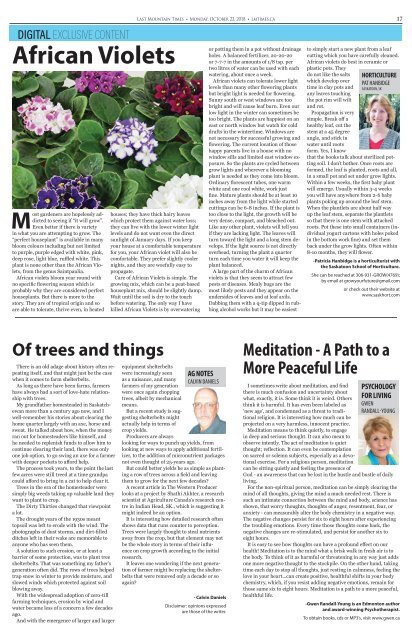LMT October 22 2018
Create successful ePaper yourself
Turn your PDF publications into a flip-book with our unique Google optimized e-Paper software.
Last Mountain Times • Monday, <strong>October</strong> <strong>22</strong>, <strong>2018</strong> • lmtimes.ca<br />
17<br />
DIGITAL EXCLUSIVE CONTENT<br />
African Violets<br />
Most gardeners are hopelessly addicted<br />
to seeing if “it will grow”.<br />
Even better if there is variety<br />
in what you are attempting to grow. The<br />
“perfect houseplant” is available in many<br />
bloom colours including but not limited<br />
to purple, purple edged with white, pink,<br />
deep rose, light blue, ruffled white. This<br />
plant is none other than the African Violets,<br />
from the genus Saintpaulia.<br />
African violets bloom year round with<br />
no specific flowering season which is<br />
probably why they are considered perfect<br />
houseplants. But there is more to the<br />
story. They are of tropical origin and so<br />
are able to tolerate, thrive even, in heated<br />
houses; they have thick hairy leaves<br />
which protect them against water loss;<br />
they can live with the lower winter light<br />
levels and do not want even the direct<br />
sunlight of January days. If you keep<br />
your house at a comfortable temperature<br />
for you, your African violet will also be<br />
comfortable. They prefer slightly cooler<br />
nights, and they are woefully easy to<br />
propagate.<br />
Care of African Violets is simple. The<br />
growing mix, which can be a peat-based<br />
houseplant mix, should be slightly damp.<br />
Wait until the soil is dry to the touch<br />
before watering. The only way I have<br />
killed African Violets is by overwatering<br />
or potting them in a pot without drainage<br />
holes. A balanced fertilizer, 20-20-20<br />
or 7-7-7 in the amounts of 1/8 tsp. per<br />
two litres of water can be used with each<br />
watering, about once a week.<br />
African violets can tolerate lower light<br />
levels than many other flowering plants<br />
but bright light is needed for flowering.<br />
Sunny south or west windows are too<br />
bright and will cause leaf burn. Even our<br />
low light in the winter can sometimes be<br />
too bright. The plants are happiest on an<br />
east or north window but watch for cold<br />
drafts in the wintertime. Windows are<br />
not necessary for successful growing and<br />
flowering. The current location of those<br />
happy parents live in a house with no<br />
window sills and limited east window exposure.<br />
So the plants are cycled between<br />
grow lights and wherever a blooming<br />
plant is needed as they come into bloom.<br />
Ordinary florescent tubes, one warm<br />
white and one cool white, work just<br />
fine. Mature plants should be at least 10<br />
inches away from the light while started<br />
cuttings can be 6-8 inches. If the plant is<br />
too close to the light, the growth will be<br />
very dense, compact, and bleached out.<br />
Like any other plant, violets will tell you<br />
if they are lacking light. The leaves will<br />
turn toward the light and a long stem develops.<br />
If the light source is not directly<br />
overhead, turning the plant a quarter<br />
turn each time you water it will keep the<br />
plant balanced.<br />
A large part of the charm of African<br />
violets is that they seem to attract few<br />
pests or diseases. Mealy bugs are the<br />
most likely pests and they appear on the<br />
undersides of leaves and at leaf axils.<br />
Dabbing them with a q-tip dipped in rubbing<br />
alcohol works but it may be easiest<br />
to simply start a new plant from a leaf<br />
cutting which you have carefully cleaned.<br />
African violets do best in ceramic or<br />
plastic pots. They<br />
do not like the salts<br />
which develop over<br />
time in clay pots and<br />
any leaves touching<br />
the pot rim will wilt<br />
and rot.<br />
Propagation is very<br />
simple. Break off a<br />
healthy leaf, cut the<br />
stem at a 45 degree<br />
angle, and stick in<br />
water until roots<br />
form. Yes, I know<br />
HORTICULTURE<br />
PAT HANBIDGE<br />
SASKATOON, SK<br />
that the books talk about sterilized potting<br />
soil. I don’t bother. Once roots are<br />
formed, the leaf is planted, roots and all,<br />
in a small pot and set under grow lights.<br />
Within a few weeks, the first baby plant<br />
will emerge. Usually within 3-4 weeks<br />
you will have anywhere from 2-6 baby<br />
plants poking up around the leaf stem.<br />
When the plantlets are about half way<br />
up the leaf stem, separate the plantlets<br />
so that there is one stem with attached<br />
roots. Pot these into small containers (individual<br />
yogurt cartons with holes poked<br />
in the bottom work fine) and set them<br />
back under the grow lights. Often within<br />
8-10 months, they will flower.<br />
-Patricia Hanbidge is a horticulturist with<br />
the Saskatoon School of Horticulture.<br />
She can be reached at 306‐931‐GROW(4769);<br />
by email at growyourfuture@gmail.com<br />
or check out their website at<br />
www.saskhort.com<br />
Of trees and things<br />
There is an old adage about history often repeating<br />
itself, and that might just be the case<br />
when it comes to farm shelterbelts.<br />
As long as there have been farms, farmers<br />
have always had a sort of love-hate relationship<br />
with trees.<br />
My grandfather homesteaded in Saskatchewan<br />
more than a century ago now, and I<br />
well-remember his stories about clearing the<br />
home quarter largely with an axe, horse and<br />
sweat. He talked about how, when the money<br />
ran out for homesteaders like himself, and<br />
he needed to replenish funds to allow him to<br />
continue clearing their land, there was only<br />
one job option, to go swing an axe for a farmer<br />
with deeper pockets to afford help.<br />
The process took years, to the point the last<br />
few acres were still treed at a time grandpa<br />
could afford to bring in a cat to help clear it.<br />
Trees in the era of the homesteader were<br />
simply big weeds taking up valuable land they<br />
want to plant to crop.<br />
The Dirty Thirties changed that viewpoint<br />
a lot.<br />
The drought years of the 1930s meant<br />
topsoil was left to erode with the wind. The<br />
photographs of dust storms, and dirt-filled<br />
ditches left in their wake are memorable to<br />
anyone who has seen them.<br />
A solution to such erosion, or at least a<br />
barrier of some protection, was to plant tree<br />
shelterbelts. That was something my father’s<br />
generation often did. The rows of trees helped<br />
trap snow in winter to provide moisture, and<br />
slowed winds which protected against soil<br />
blowing away.<br />
With the widespread adoption of zero-till<br />
farming techniques, erosion by wind and<br />
water became less of a concern a few decades<br />
ago.<br />
And with the emergence of larger and larger<br />
equipment shelterbelts<br />
were increasingly seen<br />
as a nuisance, and many<br />
farmers of my generation<br />
were once again chopping<br />
trees, albeit by mechanical<br />
means.<br />
But a recent study is suggesting<br />
shelterbelts might<br />
actually help in terms of<br />
crop yields.<br />
Producers are always<br />
AG NOTES<br />
CALVIN DANIELS<br />
looking for ways to punch up yields, from<br />
looking at new ways to apply additional fertilizer,<br />
to the addition of micronutrient packages<br />
not even thought of 25-years ago.<br />
But could better yields be as simple as planting<br />
a row of trees across a field and leaving<br />
them to grow for the next few decades?<br />
A recent article in The Western Producer<br />
looks at a project by Shathi Akhter, a research<br />
scientist at Agriculture Canada’s research centre<br />
in Indian Head, SK., which is suggesting it<br />
might indeed be an option.<br />
It is interesting how detailed research often<br />
shows data that runs counter to perception.<br />
Trees were largely thought to steal nutrients<br />
away from the crop, but that element may not<br />
be the whole story in terms of their influence<br />
on crop growth according to the initial<br />
research.<br />
It leaves one wondering if the next generation<br />
of farmer might be replacing the shelterbelts<br />
that were removed only a decade or so<br />
again?<br />
- Calvin Daniels<br />
Disclaimer: opinions expressed<br />
are those of the writer.<br />
Meditation - A Path to a<br />
More Peaceful Life<br />
I sometimes write about meditation, and find<br />
there is much confusion and uncertainty about<br />
what, exactly, it is. Some think it is weird. Others<br />
think it is harmful. It has even been labeled as<br />
‘new age’, and condemned as a threat to traditional<br />
religion. It is interesting how much can be<br />
projected on a very harmless, innocent practice.<br />
Meditation means to think quietly, to engage<br />
in deep and serious thought. It can also mean to<br />
observe intently. The act of meditation is quiet<br />
thought; reflection. It can even be contemplation<br />
on sacred or solemn subjects, especially as a devotional<br />
exercise. For a religious person, meditation<br />
can be sitting quietly and feeling the presence of<br />
PSYCHOLOGY<br />
FOR LIVING<br />
GWEN<br />
RANDALL-YOUNG<br />
God - an awareness that can be lost in the hustle and bustle of daily<br />
living.<br />
For the non-spiritual person, meditation can be simply clearing the<br />
mind of all thoughts, giving the mind a much needed rest. There is<br />
such an intimate connection between the mind and body, science has<br />
shown, that worry thoughts, thoughts of anger, resentment, fear, or<br />
anxiety - can measurably alter the body chemistry in a negative way.<br />
The negative changes persist for six to eight hours after experiencing<br />
the troubling emotions. Every time those thoughts come back, the<br />
negative changes are re-stimulated, and persist for another six to<br />
eight hours.<br />
It is easy to see how thoughts can have a profound effect on our<br />
health! Meditation is to the mind what a brisk walk in fresh air is to<br />
the body. To think of it as harmful or threatening in any way just adds<br />
one more negative thought to the stockpile. On the other hand, taking<br />
time each day to stop all thoughts, just resting in calmness, feeling the<br />
love in your heart...can create positive, healthful shifts in your body<br />
chemistry, which, if you resist adding negative emotions, remain for<br />
those same six to eight hours. Meditation is a path to a more peaceful,<br />
healthful life.<br />
-Gwen Randall‐Young is an Edmonton author<br />
and award‐winning Psychotherapist.<br />
To obtain books, cds or MP3’s, visit www.gwen.ca

















